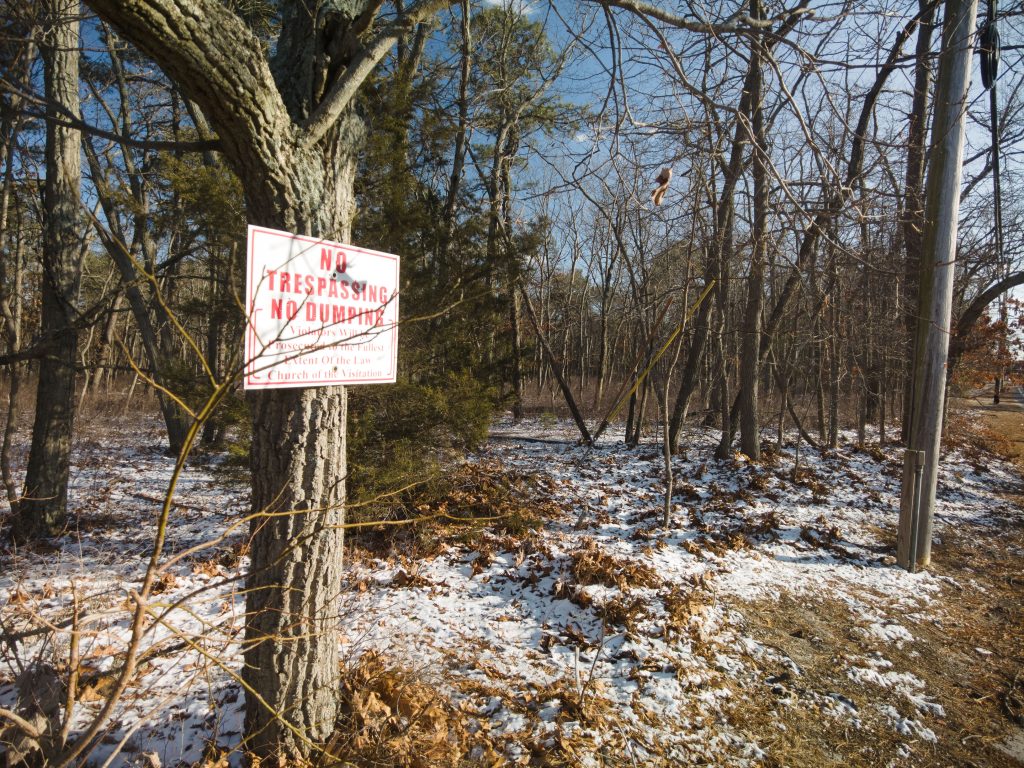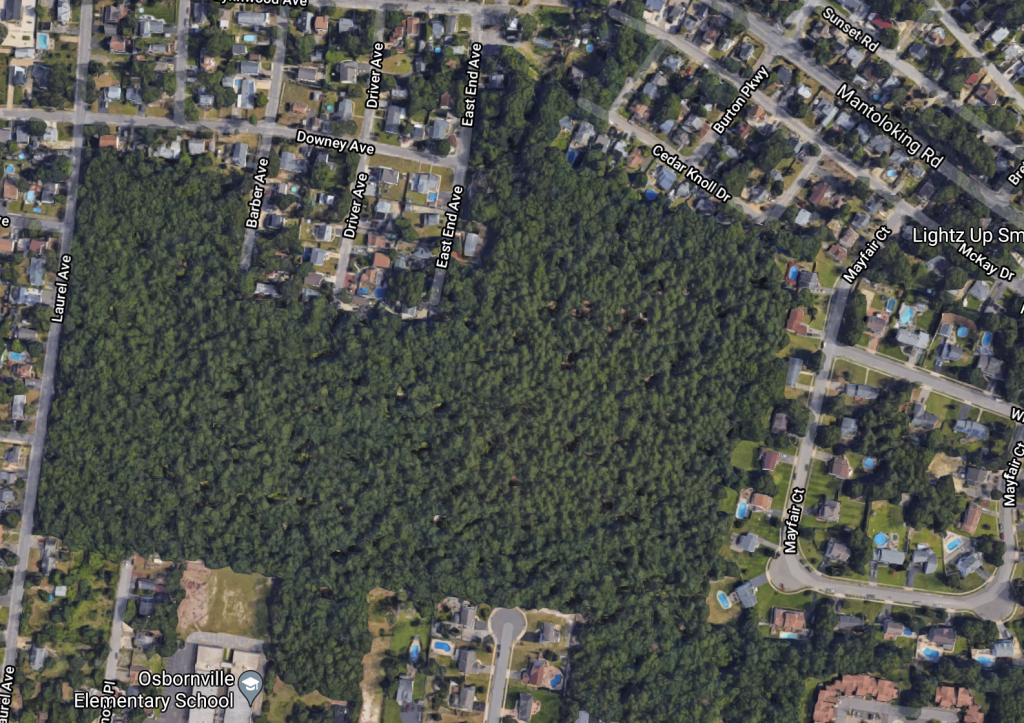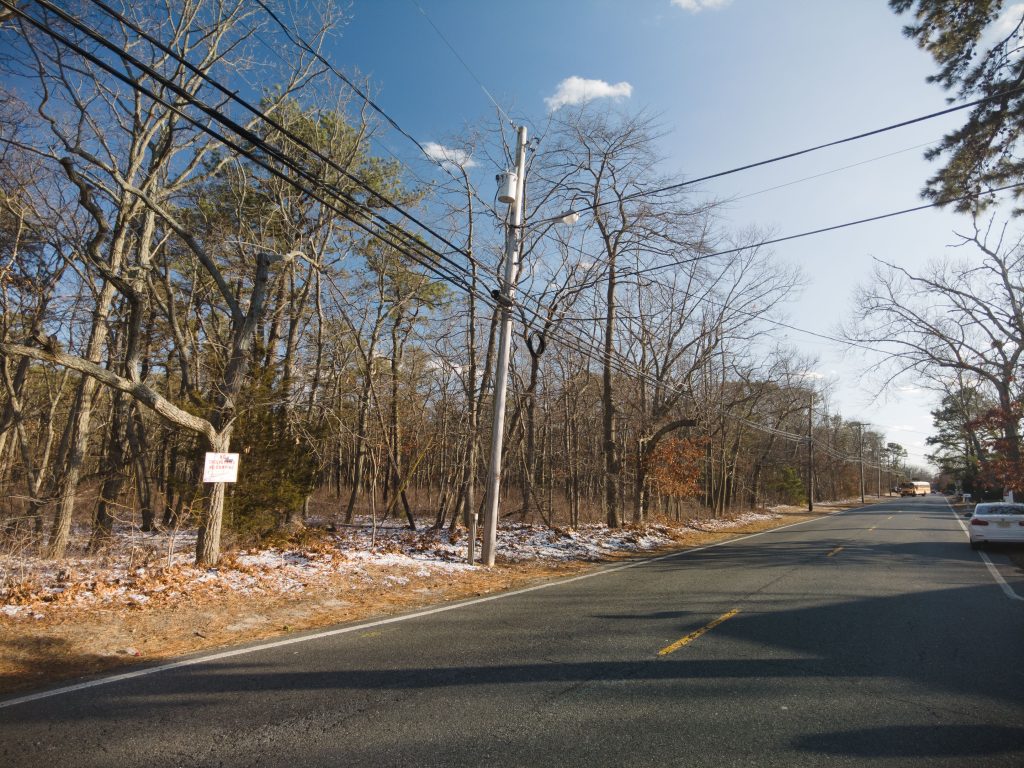
An undeveloped wooded area off Laurel Avenue in Brick, where 59 homes are proposed. (Photo: Daniel Nee)
A Texas-based construction development firm has applied for approval to build 59 homes on about 30 acres of land that is currently owned by a township church.
The homes would be built on a roughly square-shaped parcel of land off Laurel Avenue, a side street that runs between Mantoloking and Drum Point roads. The 31.63 acre property is currently owned by Visitation Roman Catholic Church, located on Mantoloking Road. Concrete news of the potential development first surfaced in June, when D.R. Horton, an Austin, Tx.-based homebuilder, engaged with the state Department of Environmental Protection on wetlands issues in the area. At the time, the developer had not submitted any detailed applications to Brick Township officials.
The status of the wetlands issue is still unknown, however the company last week formally published a required notice advising their plans. According to the notice, D.R. Horton intends to subdivide the property into 59 individual lots for the construction of single-family residences, “along with roadways, parking, sidewalks, stormwater management, lighting, landscaping, signage and related site improvements.”
|
|

A property owned by the Church of Visitation that may be slated for residential development. (Credit: Google Maps)
The property is located in the R15 zone, which requires single-family homes to be constructed on 15,000 square foot lots in order to conform to the township’s zoning ordinance.
A Cantankerous History
The lot, which according to county tax records is still owned by the church, was last the subject of development rumors in 2013. Representatives from the Diocese of Trenton indicated that the church was interested in utilizing the land for a cemetery, but the project was ultimately abandoned. The last official action taken by the planning board was the approval in March 2013 of a reverse subdivision request that converted three separates lots into two. At that hearing, which encompassed the total area of the parcel, the board approved the creation of one 10-acre lot and one 24-acre lot.

An undeveloped wooded area off Laurel Avenue in Brick, where 59 homes are proposed. (Photo: Daniel Nee)
Residents were served with notifications around the same time, stating that the church was planning a 7,000 plot cemetery at the site. David Roskos, an attorney for the diocese, told board members that any development at the site would be “religious based.”
At the time, Roskos openly warned residents who attended the meeting that if they opposed the cemetery plan, the site could be sold to a real estate developer.
“If the church sold this to a builder, and the builder came in to build houses, he could put lots in next to the existing lots that are there. You would not have trees and you would not have a buffer,” Roskos said at the time. “I understand there are concerns here; we’re trying to be sensitive to the local neighborhood while we develop our religious uses.”
Some questions remain outstanding regarding the viability of property, which presumably will be answered at the upcoming meeting. The state’s Coastal Areas Facilities Review Act limits impervious coverage – portions of the property physically covered by a building or hard surface, such as a driveway or patio – to 30 percent of the total land area in certain locations. On top of that requirement, a local ordinance only allows developers to count land that is not portions of wetlands or buffers toward the total allowable area for construction, which officials have said could force the requirement of a use variance.
Meeting Scheduled
The notice did not include any word of intent for the developer to seek any specific variances for the project, indicating that no use variance will be required. This means support from a simple majority of board members, rather than a supermajority, will be needed for approval.
D.R. Horton is being represented by local attorneys, the Red Bank-based firm of Giordano, Halleran & Ciesla.
The hearing will take place before the township’s planning board, scheduled for Feb. 23 at 7 p.m. at the township municipal complex.

Advertisement

Police, Fire & Courts
Teacher From Brick, 36, Charged With Carrying on Affair With Student
Brick Life
Adult Autism Transition

Police, Fire & Courts
Teacher From Brick Charged in Another Sex Affair With Student








